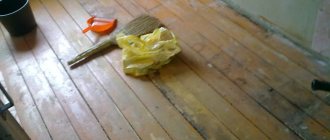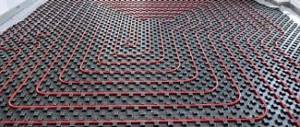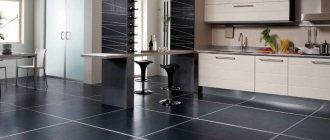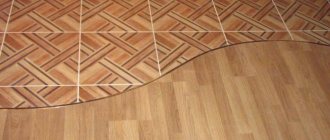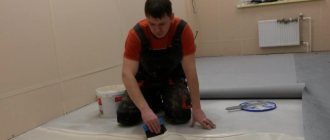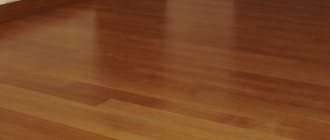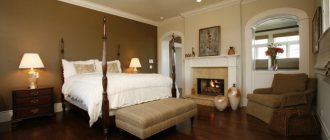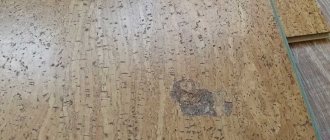Here you will learn:
- Which warm floor is better to lay under linoleum
- Choosing linoleum for heated floors
- Types of substrates
- Types of insulation
- Types of materials for floor waterproofing
- Installation of a warm water floor under linoleum
- Installation of infrared floor under linoleum
- Installation of electric heated floor
Despite all its positive aspects, linoleum is not the best finishing material. After all, it has increased heat-insulating properties; in addition, when heated, it can change shape and color. The main disadvantage is the release of harmful substances under the influence of high temperature.
But if you want linoleum, then you should choose the right flooring model and heating method. In addition, it is necessary to strictly follow the installation rules and temperature conditions - heating must be uniform and smooth.
The concrete base also has its own requirements - it must be smooth and even (permissible deviations 0.2 cm per 2 m2), well cleaned and covered with a layer of primer. In addition, waterproofing is required, and a compensation tape made of foamed polyethylene is applied along the walls over the entire area.
For your information! Most brands of linoleum have an insulating layer, so there is no need for an additional backing. However, some of these materials trap the heat coming from the heating device.
Since linoleum cannot be heated above 30 degrees, it is necessary to equip the system with a sensor and thermostat to regulate the temperature.
Which warm floor is better to lay under linoleum
Heated floors take energy for heating from the distribution of the central heating system or from the household electrical network. Based on this, in houses and apartments, two configurations of heated floors can be installed under a wooden (or concrete) floor - electric and water.
When choosing which warm floor to lay under linoleum, special attention should be paid to the operating temperature. This is due to the fact that linoleum is very susceptible to intense heating; moreover, it is important to produce heating evenly and smoothly.
Infrared heated floors are best suited for heating wooden floors under linoleum. Due to its high efficiency, such a warm linoleum floor heats only people and objects, but not the entire volume of air in the room.
Film heated floors are versatile, and installing them yourself is quite simple. This system is compatible with all types of linoleum and does not have a negative impact on the appearance and characteristics of the coating. This is due to the dense arrangement of the conductor strips, which makes it impossible for the linoleum to overheat.
The water heated floor system also goes well with linoleum on a wooden floor; in addition, the presented design allows you to significantly save on energy. The water floor heats up to 50-55°C, and the linoleum begins to deform at 57°C; also, such a heating system distributes heat evenly and can easily be installed with your own hands. The only disadvantage of water heating is that the base floor will have to be raised by 10 cm.
Unlike a water floor, it is better not to use rod and cable floors in combination with linoleum, which will be laid on a concrete floor. This is due to the uneven distribution of heating, which can lead to disruption of the shape and subsequent deformation of the linoleum covering. Water heated floors have an undeniable advantage here.
Important! Before laying linoleum on a wooden floor, you need to ensure that the power value of the heated floor does not exceed 150 W/m2, otherwise the coating will dry out and become deformed.
Types and features of linoleum
First, let's look at the positive aspects of linoleum. Why do many people prefer to put it in?
We recommend: How does the underfloor heating calculator work?
Positive sides:
- It is convenient to clean rooms with linoleum;
- easy installation and dismantling;
- resistant to stains;
- long wear under correct operating conditions;
- repels water;
- certain types are resistant to high temperatures;
- affordable prices and wide selection on the market;
- combines with other building materials;
Some people choose other coatings for the following reasons:
- color changes over time;
- the drawing is erased;
- does not withstand low temperatures well;
- linoleum made from polyvinyl chloride has an unpleasant odor;
In order for the flooring to be of high quality and last for many years, it is necessary to understand its types and characteristics. Don't be put off by price alone.
Expensive material, in turn, can be bad if installed in inappropriate conditions, just as cheap material can be good if used correctly.
Although in some cases it is better to overpay a little for quality than to ignore important characteristics by choosing a cheaper and more accessible material.
Linoleum is divided into 3 classes according to the place of use:
- domestic. Withstands light load, suitable for installation in residential premises;
- semi-commercial. Used in commercial buildings with medium load;
- commercial. The most durable and thick type of linoleum, it is used in public institutions with a large flow of people;
We sorted out the classes. Now let's move on to the 5 main subtypes of linoleum:
- natural. It has increased fire resistance and resistance to electricity due to the organic components in the composition. Eco-friendly and safe for both people and pets. Durable and wear-resistant type of linoleum. Among the disadvantages are fragility during transportation, a flat surface is required for flooring, unstable to moisture, expensive price;
- linoleum-PVC. It does not tolerate high temperatures well, deforms over time, is easily flammable, is unstable to substances with caustic chemical composition, and has an unpleasant odor. The material is definitely not suitable for heated floors;
- alkyd (glyphthalic) linoleum. Fabric-based coating with the addition of natural ingredients, which increased the cost in the market. The products are endowed with increased thermal insulation and various designs. Disadvantages - does not withstand temperature changes, deforms over time, transportation in the cold season is not recommended;
- nitrolinoleum (colloxylin). Single-layer material based on nitrocellulose. Small thickness has both pros and cons. The first include light weight, flexibility, and plasticity. For the second, it insulates noise and heat poorly, requires a completely flat floor for installation, supports combustion, and ignites without problems;
- rubber. Two-layer coating based on rubber. Plasticity and moisture retention are guaranteed, and the rubber coating also adds anti-slip properties. Antistatic, resistant to temperature changes. Found application in public buildings, medical institutions, sports institutions.
We recommend: How to install heated floors under PVC?
The above types and their characteristics will help you make the right choice, based not only on price, but also on the most important qualities of the material. It would also be a crime not to touch on the types of heated floors, because in order to choose the ideal combination, you need to know the characteristics of both.
Choosing linoleum for heated floors
Traditional linoleum is a material made from synthetic resins. It can be laid on any surface, and it has different textures and colors. However, when exposed to temperatures above 250C, the material begins to warp, lose shape and, as a result, durability. In addition, this type of linoleum is a fire hazard, so its use for heated floors is unacceptable.
Linoleum for heated floors is usually indicated by the following icons:
Another flooring option is marmoleum. In essence, it is similar to linoleum, but natural wood flour and linseed oil are used for its production. Thanks to this, the material has the following features:
- fire resistance: the material does not burn or smoke;
- wear resistance: does not wear out, is resistant to dirt, service life up to 30 years;
- antibactericidal properties: microorganisms do not multiply on this type of coating;
- operation at temperatures up to 280C.
The last feature suggests that the material will interact perfectly with infrared heated floors.
The golden mean would be multilayer PVC linoleum, which is also suitable for heated floors. True, the environmental friendliness of this material is much lower than that of marmoleum.
If we talk about prices, the approximate cost is as follows: linoleum - from 150 rubles / sq.m., multilayer PVC material - from 400 rubles / sq.m., marmoleum from 800 rubles / sq.m. Knowing the approximate prices, you can purchase the material according to your financial capabilities.
Types of substrates
To insulate the floor under linoleum, you first need to select a substrate. There are several types of such material. Here are the most popular:
- cork;
- jute;
- linen
Let's look at each separately.
Cork backing is made from compressed crushed cork oak bark. This insulation is produced in rolls. The advantages of this material include:
- environmental friendliness - made from natural cork;
- There is a pleasant feeling when walking on this surface, as it is quite soft.
It is precisely because of the last positive quality mentioned that a problem may arise: if you place a heavy object on the coating, then after some time dents may form on it. To avoid this, you should choose the hardest cork backing.
Jute backing is a material consisting of 100% natural jute fiber. It is made as follows: jute fibers are punched with a needle, then rolled on rollers under high temperature. This substrate is fire resistant, resistant to mold and rot.
Linen backing is 100% pure natural linen. It is made by double-piercing with a needle and then impregnated with anti-fire and anti-fungal agents. Linen backing is a good material for thermal insulation under linoleum.
Installation of cable heating
Electric cable flooring is laid under linoleum in the same way as under other types of coverings. The cable itself is completely filled with screed, and the installation of the floor covering is carried out after the concrete has dried. The power of the heating cable should be selected so that it is no more than 150 W/m2. This is very important when you install warm floors under linoleum yourself.
Further installation work is performed in the following sequence:
- At the first stage, you need to prepare the rough covering of the wooden floor. It is cleaned of dust and debris, treated with a primer, all weak areas and cracks are sealed or puttied.
- Next, the floor is insulated with expanded polystyrene slabs with a thickness of 50 to 100 mm. Instead of plates, it is allowed to use heat-insulating roll material, the basis of which is foamed polyethylene. It is available with a reflective layer protected by a polymer coating. If such a coating is not available, an additional polyethylene film is laid out to protect the reflective layer from the corrosive effect of the cement mortar.
- Then a cable mount made of metal or plastic slats is installed. The established distance is maintained between them. Instead of slats, you can use steel mesh.
- The pitch of the underfloor heating cable is calculated in advance so that the specified power is provided. After this, it is fixed in special grooves.
- The temperature sensor is installed between any two cable turns. It connects to a wire hidden in a corrugated pipe, and then to a thermostat.
The finished system is connected to the electrical network and checked for a short time for possible breaks and other malfunctions. After this, the entire structure is filled with a tie layer with a layer thickness of at least 90 mm. With a smaller thickness of the solution, the linoleum opposite the cable will constantly overheat and fail very quickly. The floor covering is laid only after the screed is completely dry. Before installation, heated floors are turned off.
Types of insulation
You can use the following types of insulation to insulate the floor under linoleum:
- penoplex;
- isolon.
Penoplex insulation is distinguished by its durability and long service life. This material is often used to insulate various surfaces. The thickness of these slabs is small, so the floor level rises to an insignificant height (for more details: “How to insulate a floor with penoplex - proven methods”).
This insulation for linoleum on a concrete floor has a significant advantage - it is easy to install; if necessary, it can be cut with an ordinary knife. It is the most popular among insulation materials.
Isolon is polyethylene foam with a closed cell structure. Has excellent characteristics:
- high thermal insulation rates;
- vapor barrier qualities;
- waterproof;
- safe;
- durable.
In addition, the cost of isolon is low.
There are two types: non-foil and foil insulation under linoleum.
Types of materials for floor waterproofing
Paint insulation
Such compositions can be used for waterproofing when insulating wooden and concrete floors. Silicone, acrylic, rubber, polymer based mastics are applied to the surface using a brush or roller. The layer of such insulation is 3-6 millimeters.
Coating insulation
It is very common and is used to protect internal and external surfaces from moisture. When applied, it forms a monolithic layer of high density. It is a bitumen-polymer base with the addition of solvents and additives that increase plasticity. Very reliably protects the treated subfloor. Coating insulation used for floor insulation will significantly increase the efficiency of insulation.
Pasted waterproofing
It is produced in the form of rolls and is a durable fiberglass base coated with a bitumen-binding composition with the addition of polymers. Very easy to install. On one side there is a self-adhesive base. The installation of such waterproofing for insulation can be done with your own hands without the use of professional equipment and tools. Affordability complements the advantages of adhesive insulation.
Installation of a warm water floor under linoleum
To install a heated floor, you must purchase the following materials:
- polyethylene film, the thickness of which is 150 microns;
- polystyrene plate with a thickness of more than 20 mm (with “bobs”);
- reinforcing mesh;
- damper tape;
- inlet and outlet manifolds;
- pipe for heated floors made of cross-linked polyethylene.
The schematic design of a warm water floor clearly shows that the pipe is located inside a concrete screed, so each circuit consists of a whole segment.
Installation of a warm water floor begins by ensuring waterproofing and thermal insulation of the concrete base, which must be smooth and clean. A polyethylene film is laid on the thoroughly leveled screed.
Adjacent panels are secured with construction tape. Polystyrene slabs with special elevations called “bobs” are laid on the film.
Lugs are needed to quickly secure the flexible pipe of a heated floor in the desired configuration.
The placement of a polyethylene or metal-plastic pipe for a water-heated floor on special mats with bosses. Additionally, the system is fixed with reinforcing mesh
The size of the pipe laying step is from 10 to 30 cm. The choice of laying step is influenced by the amount of heat loss in the room equipped with a heated floor. On average, it takes about 5 linear meters of polyethylene pipe per square meter of heated space.
A reinforcing mesh is laid on top of polystyrene slabs with a pipe fixed between the bosses, which is needed to strengthen the concrete screed in which the warm water floor system is hidden.
A damper tape is laid along the entire perimeter of the room along the walls, which can compensate for the thermal expansion of the cement screed. Then connect one end of the pipe to the inlet manifold, and the other to the outlet. The mixing unit is fixed in a manifold cabinet screwed to the wall of the room.
At this point, the installation of the pipe for the heated floor is considered complete. The screed is poured. Linoleum is not laid on the concrete screed itself, but on sheets of plywood. Other floor coverings can be placed without the use of plywood in accordance with the requirements of their installation technology.
The advantages of installing a heated floor system in a house are clearly presented in the diagram. Warm floors under linoleum are used as additional heating to the existing heating system
You can use a water heated floor as additional heating to a radiator system. If desired, a warm floor can completely replace it, acting as an independent supplier of heat in the house.
Water underfloor heating operates on any energy source: gas, liquid fuel, electricity. This does not require heating the coolant in the system to high temperatures. At the entrance to the circuit, the coolant temperature is 30-40 degrees.
The pressure in the water heating system starts from 2 atm. Due to this, it is possible to ensure energy savings and achieve gentle operation of system elements compared to other alternative types of heating.
During operation of the water heating system, no electromagnetic radiation is generated, the effects of which are harmful to human health. Since there are no detachable connections in the floor, the likelihood of a leak is zero.
The service life of the system is 50 years or more.
Electric heated floor: pros and cons
Warm floors are an extremely convenient system. It can be used as the main method of heating a home, which has significant advantages over traditional water heating. But more often, heated floors are installed as an additional source of heat, designed to solve local problems.
For example, it is very good if the floor in the bathroom, on an insulated loggia or in the hallway has a comfortable temperature. Such a project is much cheaper than installing the system throughout the apartment, and installation time will be much less. First you need to decide on the type of floor heating system.
You will have to choose between a water and electric system. In the first case, heating is carried out by hot water circulating through pipes that are laid in a screed under the floor covering. A water heated floor is considered cheaper to operate, since it is like a branch of the heating system of the house.
Alas, such systems are prohibited by building codes for installation in multi-apartment high-rise buildings; they can only be installed in private homes. Electric heated floors are more diverse. A heating cable or special infrared film can be used as a heating element.
This diagram shows the installation of a film heated floor: insulation is laid on the subfloor, then the film is mounted, and covered with a layer of vapor-permeable material on top
This type of flooring is more expensive, but it is easier to install, and the operation of electrical systems can be adjusted more accurately and quickly than with water heating. Therefore, in apartments, and even in private houses, preference is given to electric underfloor heating. But choosing a system is only half the battle. You need to choose the right flooring.
Ceramic tiles combine perfectly with any heated floor, but this type of coating is not acceptable everywhere and not always. Linoleum is distinguished by its availability, low price, and the possibility of quick and easy installation, but it does not combine with heated floors as well as we would like.
Firstly, because this flooring does not conduct heat very well, and this somewhat reduces the efficiency of the heating system. Secondly, because linoleum itself does not tolerate heat very well. Prolonged exposure to high temperatures can cause the following unpleasant phenomena:
- changing the color of the floor covering;
- deformation of its surface and swelling;
- release of phenol fumes into the air, a substance hazardous to health.
And yet, linoleum is quite successfully installed on top of a warm floor. You just need to choose the right flooring. For example, there are types of linoleum with a thick base that protects against the effects of cold.
Such a material with reduced thermal conductivity is not suitable. But too thin linoleum is also not acceptable - it will repeat all the unevenness of the subfloor, and the wear resistance of such a material is usually low.
Marmoleum is a so-called natural linoleum that tolerates heat well and does not emit any hazardous substances.
Modern linoleum has markings indicating whether this material is suitable for heated floors or not. There are good reviews about marmoleum, which is also called natural linoleum.
Marking linoleum for use under heated floors
This coating is made from natural ingredients that do not emit anything harmful. At the same time, marmoleum demonstrates good resistance to heat and wear.
“Unnatural” types of linoleum are also quite acceptable. To prevent the coating from deteriorating, you just need to maintain the correct temperature conditions. The operating temperature of a heated floor usually varies between 25-28 degrees. If this limit is not exceeded, linoleum will withstand even prolonged heating.
Installation of infrared floor under linoleum
There is nothing particularly complicated about installing the heating system in question. Anyone who knows how to use pliers, scissors, a tape measure and a screwdriver can handle its installation. To install a thermostat on the wall and lay the cable for it, you will also have to use a hammer drill. But the list of necessary tools is limited to this.
Which linoleum is suitable
Infrared heated floors under linoleum are installed in four stages:
- Working out the layout of the film in the room.
- Preparing the base.
- Laying heating elements.
- Connecting electrical wiring and checking the functionality of the system.
If everything is done correctly, then all that remains is to lay the linoleum on top. And that’s it, you can walk on the warm and beautiful floor. Moreover, if a split air conditioning system is installed for an apartment or a well is drilled on the site, usually with the involvement of outside specialists, then it will be quite possible to install the IR thermal film with your own hands. There is simply nothing super complex in the composition of this electric floor. It is even more problematic to understand the design and adjustment of plastic windows from scratch.
Types of linoleum
Drawing up an installation diagram
Film heated floors under linoleum are not laid over the entire area of the room, but only in its open areas. You cannot place heating film under furniture and household appliances. It can get damaged and tear there. Plus, in such areas, local overheating of the coating and elements of the infrared system itself will occur. To avoid making mistakes, you need to draw up a floor plan in advance indicating all such places.
IR thermal underfloor heating film is placed:
- exclusively in the middle of the room where people will walk;
- with a distance from the walls of 5–10 cm;
- at a distance of 30–50 cm from radiators, fireplaces and stoves with ovens;
- stripes not overlapping and with a cut only across in the places indicated on the film.
All these installation nuances must be taken into account when drawing up the plan. Also on it you should immediately determine the installation location of the thermostat (temperature regulator) and temperature sensor for the infrared heated floor. It is not recommended to install the underfloor heating system in question without these two elements.
Types of IR floors
Preparing the base
The rough base for a heated floor under linoleum should be smooth and free of debris. Any pebble or dent with sharp edges may damage the film.
If there are irregularities of more than 2 mm in height, they must be eliminated. Such defects will have to be either removed by grinding or smoothed with a solution. And if the base has a large number of flaws and is not even, then it will need to be trimmed with a thin concrete screed 2–3 cm thick.
Leveling the floor under linoleum and thermal film can also be done with flooring. Sheets of plywood, fiberboard or gypsum fiber board are suitable for this. They are even easier to install than pouring concrete. Just first you need to weigh all the pros and cons of dry floor screeding in this way. This technology is not suitable for every room.
Preparing the base
Installation and laying of film elements
Heat-reflecting isolon or its equivalent is laid on top of the leveled base. It is needed so that the heat goes up into the room, and does not accumulate uselessly in the linoleum flooring cake or floor slab.
Installation of heating elements is carried out as follows:
- The film is cut according to plan.
- The cut pieces are laid out on the floor.
- The wires are being connected.
- A temperature sensor with a cable to the thermostat is installed.
- The correct connection of all elements is checked.
Heated floor installation
To connect the electrical wiring to the thermal film, special terminals are used that come with the infrared heated floor. To prevent short circuits and sparking, they must be sealed with bitumen insulation.
The film is fixed to the rough base using heat-resistant tape. You can also use nails or staples for fastening. However, they are only allowed to pierce the thermal film on its sides, where there are transparent stripes. If you accidentally damage the carbon heating element, then such a cut will have to be removed. It is unacceptable to use pieces of film flooring damaged in this way.
The temperature sensor is attached to the bottom of the film. Under it you will need to make a cutout in the heat-reflecting substrate. And if it is large in size, then it is better to initially make a groove in the screed for this sensor and cable to the thermostat.
Step-by-step scheme for laying heated floors
Network connection
If the installed heated floor is designed for consumption of less than 2 kW, then it is allowed to be connected to the power supply through a regular outlet. Otherwise, you will have to lay a separate line from the distribution board.
Connection of individual parts of the IR floor into a single system is carried out in parallel. And the wires are led out to the wall to be later hidden in the baseboard. After connecting all the cables, the thermal film is turned on to heat up to 25–27 0C. At this stage, you need to check whether the terminal contacts are heating up (they were poorly crimped with pliers) and whether all the carbon heating elements are working at all.
At the end of the installation, polyethylene with a thickness of 100–150 microns is laid over the thermal film. And then a 3-5 mm thick flooring is made from fiberboard, gypsum fiber board or plywood sheets. Laying linoleum on top of a film heated floor is immediately prohibited. The soft finish must have a rigid underlay, otherwise the heating elements will be subjected to too high tensile loads.
Connecting mats to the network
How to lay linoleum on a warm floor?
After installing the heating floor system and fully checking its functionality, you can lay linoleum. Absolutely anyone can do this. Before laying, do not forget to spread the roll in the room and warm it up for 24 hours.
This will allow the material to fully expand and fill the space evenly. Now the sheet can be cut into strips of the desired size and laid over the entire area of the room. We secure the edges with a plinth, and make a cutout in the places for the wire if the plinth does not have a built-in cell.
Certain types must be glued to the surface. To do this, mastic is used, which is evenly applied to the plywood, then the elements are connected.
